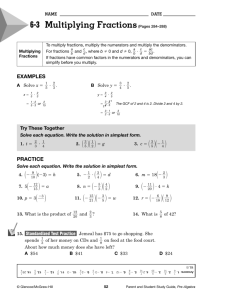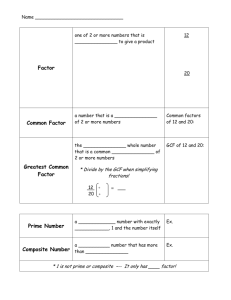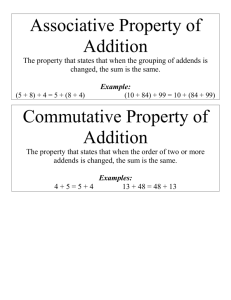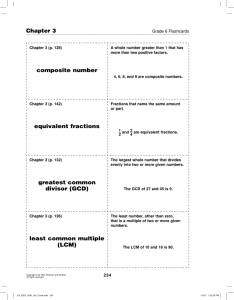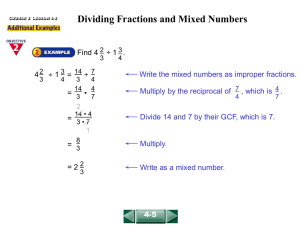Pre-Algebra Notes – Unit Four: Factors, Fractions, and
advertisement
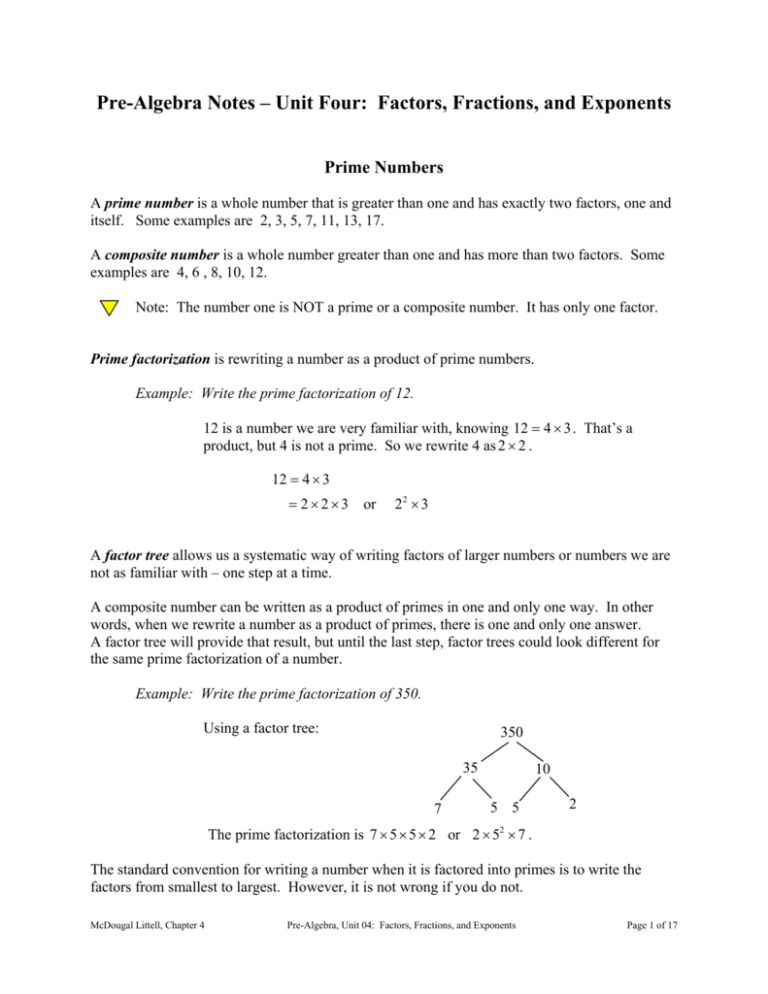
Pre-Algebra Notes – Unit Four: Factors, Fractions, and Exponents Prime Numbers A prime number is a whole number that is greater than one and has exactly two factors, one and itself. Some examples are 2, 3, 5, 7, 11, 13, 17. A composite number is a whole number greater than one and has more than two factors. Some examples are 4, 6 , 8, 10, 12. Note: The number one is NOT a prime or a composite number. It has only one factor. Prime factorization is rewriting a number as a product of prime numbers. Example: Write the prime factorization of 12. 12 is a number we are very familiar with, knowing 12 4 3 . That’s a product, but 4 is not a prime. So we rewrite 4 as 2 2 . 12 4 3 2 2 3 or 22 3 A factor tree allows us a systematic way of writing factors of larger numbers or numbers we are not as familiar with – one step at a time. A composite number can be written as a product of primes in one and only one way. In other words, when we rewrite a number as a product of primes, there is one and only one answer. A factor tree will provide that result, but until the last step, factor trees could look different for the same prime factorization of a number. Example: Write the prime factorization of 350. Using a factor tree: 350 35 7 10 5 5 2 The prime factorization is 7 5 5 2 or 2 52 7 . The standard convention for writing a number when it is factored into primes is to write the factors from smallest to largest. However, it is not wrong if you do not. McDougal Littell, Chapter 4 Pre-Algebra, Unit 04: Factors, Fractions, and Exponents Page 1 of 17 The preferred way to write 350 as a product of primes is 2 52 7 , but it could have been written as 7 52 2 . If the factor tree for finding the prime factorization of 350 had begun with the factors 70 and 5, the result would have still been the same. The factor tree would look different than the one shown, but the answer would have been the same. Another way to determine the prime factorization of a composite number is to use repeated division. This is especially helpful when the composite number is unfamiliar to us, and finding a pair of factors with which to begin a factor tree is not obvious. The process starts by checking for divisibility by the smallest prime number (2) and dividing until you can no longer use that as a factor. Then move on to checking the next prime number and so on until you get an answer that is prime. When you are finished, all the prime factors will be lined up and grouped together, making the writing of powers much easier. Example: Write the prime factorization of 3024. Using repeated division: 2 3024 2 1512 2 756 2 378 3189 3 63 3 21 7 The prime factorization is 2 2 2 2 3 3 3 7 or 24 33 7 . Knowing the rules of divisibility will help with factoring. Review of Rules of Divisibility To find factors, determine if a number is divisible by: 2 5 10 3 9 if it ends in an even number if it ends in 0 or 5 if it ends in 0 if the sum of the digits is divisible by 3 if the sum of the digits is divisible by 9 McDougal Littell, Chapter 4 Pre-Algebra, Unit 04: Factors, Fractions, and Exponents Page 2 of 17 6 4 8 7 if the number is divisible by 2 and 3 if the last two digits of a number are divisible by 4 if the last three digits are divisible by 8 take the last digit, double it, subtract it from the rest of the number; if it is 0 or divisible by 7, then the number will also be divisible by 7 (repeat this algorithm if necessary) Example: Is 3164 divisible by 7? 4 2 8, 316 8 308; for 308, 8 2 16, 30 16 14, which is divisible by 7 So,3164 is divisible by 7. 11 take the last two digits, add them to the rest of the number; if it is divisible by 11, then the number will also be divisible by 11 (repeat this algorithm if necessary) Example: Is 637,846 divisible by 11? 46 6378 6424 64 24 88and we know this to be divisible by11 So, 637,846is divisible by11also. Greatest Common Factor Syllabus Objective: (3.3) The student will find factors, including the greatest common factor (GCF), of numbers and monomials. A common factor is a whole number that is a factor of two or more nonzero whole numbers. Example: Find common factors of 18 and 24. Factors of 18: Factors of 24: 1, 2, 3, 6, 9, 18 1, 2, 3, 4, 6, 8, 12, 24 Since 1, 2, 3, and 6 are factors of both of the numbers 18 and 24, they are called common factors. The greatest common factor (GCF) of two or more whole numbers is the greatest whole number that divides evenly into each number. In the first example, the greatest common factor (GCF) of 18 and 24 is 6. There are three ways of finding the GCF. McDougal Littell, Chapter 4 Pre-Algebra, Unit 04: Factors, Fractions, and Exponents Page 3 of 17 Example: Find the GCF of 24 and 36. Strategy 1: To find the GCF, list all the factors of each number. The largest factor that is in both numbers is the GCF. Factors of 24: 1, 2, 3, 4, 6, 8, 12, 24 Factors of 36: 1, 2, 3, 4, 6, 9, 12, 18, 36 The GCF is the greatest factor that is in both lists: 12. Strategy 2: To find the GCF, write the prime factorization of each number and identify which factors are in each number. 24 2 2 2 3 36 2 2 3 3 Each number has two 2’s and one 3. So the GCF 2 2 3 12 Strategy 3: Use a Venn diagram. . Draw overlapping circles, one for each number. Write the factors for each number in its circle, placing common factors in the intersection(s). Finally, multiply all factors in the intersection. Factors of 36 Factors of 24 2 223 3 Multiply all factors in the intersection for the GCF: 2 2 3 12 . Note: If there are no numbers in the intersection that means the GCF is one. That also means that the numbers are relatively prime. Two or more numbers are relatively prime if their greatest common factor is one. Examples: 2 and 5 are relatively prime 8 and 9 are relatively prime 8 and 12 are NOT relatively prime; they have a GCF of 4 Example: Find the GCF of 8 and 9. Factors of 9 Factors of 8 222 3 3 There are no factors in the intersection, so the GCF 1. McDougal Littell, Chapter 4 Pre-Algebra, Unit 04: Factors, Fractions, and Exponents Page 4 of 17 Example: Find the GCF of 18xy2 and 28x2y2 Writing the factors: 18 xy 2 2 3 3 x y y 28 x 2 y 2 2 2 7 x x y y The common factors are 2 x y y , so the GCF is 2 xy 2 . Using a Venn diagram: Factors of 28 x 2 y 2 Factors of 18 xy 2 3 3 2 x y y 27 x Multiply all factors in the intersection for the GCF: 2 x y y 2 xy 2 . Don’t forget to include word problems where the GCF would help students to solve them. Example: A flower shop wants to make bouquets from 3 types of flowers. The flowers available are 45 daisies, 75 roses, and 60 mums. What is the greatest number of identical bouquets that can be made? List what each bouquet will contain. Let’s find the GCF for 45, 75 and 60. 45 3 3 5 75 3 5 5 60 2 2 3 5 The common factors are 3 and 5, so we multiply 3 times 5 to get GCF = 15. We can make 15 identical bouquets. Each would contain: 45 15 3 daises 75 15 5 roses 60 15 4 mums Equivalent Fractions Have you ever noticed that not everyone describes the same things in the same way? For instance, a mother might say her baby is twelve months old. The father might tell somebody his baby is a year old. They’re the same thing, no big deal. Well, we do the same thing in math, or in our case, with fractions. Let’s look at these two cakes. McDougal Littell, Chapter 4 Pre-Algebra, Unit 04: Factors, Fractions, and Exponents Page 5 of 17 One person might notice that 1 out of 2 pieces seems to describe the same amount as 2 out of 4 1 2 in the picture above. In other words, . 2 4 If we continue this process, we would notice we have a number of different ways to express the same thing. When two fractions describe the same amount, we say they are equivalent fractions. Equivalent fractions are fractions that have the same value. Wouldn’t it be nice if we could determine when fractions were equivalent without drawing pictures? Well, if we looked at enough equivalent fractions, we would notice a pattern developing. Let’s look at some. 1 3 , 2 6 3 6 , 4 8 2 10 , 3 15 and 3 30 . 5 50 Do you see any relationship between the numerators and denominators in the first fraction compared to the numerators and denominators in the second? Hopefully, you might notice we are multiplying both numerator and denominator in each fraction by the same number to get the 2nd fraction. Example: 5 20 if you multiply both the numerator and denominator by 4 6 24 Well, you know what that means: when we see a pattern like that, we make a(n) rule, algorithm or procedure that allows us to show other people simple ways of doing problems. To generate equivalent fractions, multiply BOTH the numerator and the denominator by the SAME number. When you multiply both the numerator and the denominator by 4, you are multiplying by 4 4 or 1. When you multiply by one, the value of the original fraction does not change. Example: Express 5 as sixtieths. 6 5 ? What did you multiply 6 by to get 60 in the 6 60 denominator? By 10, so we multiply the numerator by 10. So McDougal Littell, Chapter 4 5 50 . 6 60 Pre-Algebra, Unit 04: Factors, Fractions, and Exponents Page 6 of 17 Example: 2 is how many thirty-fifths? 7 2 ? 7 35 What did you multiply 7 by to get 35 in the denominator? By 5 you say. We then multiply the numerator by 5. 2 10 7 35 Simplifying/Reducing Fractions Simplifying or reducing fractions is just another form of making equivalent fractions. Instead of multiplying the fraction by one, by multiplying the numerator and denominator by the same number, we will divide the numerator and denominator by the same number. Now that we know the Rules of Divisibility, reducing fractions is going to be a piece of cake. To reduce fractions, we divide both the numerator and denominator by the same number. Example: Simplify (reduce) 18 . 20 Both the numbers are even, so we can divide both numerator and denominator by 2. 18 2 9 20 2 10 Example: Simplify (reduce) 111 . 273 Notice that the sum of the digits in 111 is 3 and the sum of the digits in 273 is 12. Therefore, both are divisible by 3. 111 3 37 273 3 91 McDougal Littell, Chapter 4 Pre-Algebra, Unit 04: Factors, Fractions, and Exponents Page 7 of 17 If you don’t know the rules of divisibility, you would have to try and reduce the fractions by trying to find a number that goes into both numerator and denominator. That’s too much guessing, so spend a few minutes and commit the rules of divisibility to memory. The rules of divisibility and the GCF are tools we can use to help us to simplify fractions. We use those same ideas to reduce rational expressions in algebra. Example: Simplify 10 xy . 15 y 2 10 xy 2 5 x y 15 y 2 3 5 y y 2x 3y Least Common Multiple/Denominator Syllabus Objective: (3.4) The student will find multiples, including the least common multiple (LCM), of numbers and monomials. A multiple is the product of a number and any nonzero whole number. Example: 15 is a multiple of 3 because 5 3 15 Example: Three multiples of 12 are 12, 24, and 36. The least common multiple (LCM) of two or more numbers is the common multiple with the least value. It’s a number all the other numbers will divide into. For that to occur, the LCM has to contain all of the factors of each of the numbers. There are a number of ways of finding the LCM. Example: Find the LCM 10 and 15. Strategy 1: List the multiples of each number and find the multiple with the least value on each list. Multiples of 10: Multiples of 15: 10, 20, 30, 40, 50, 60, … 15, 30, 45, 60, … Both these numbers have 30 as the least common multiple; the LCM is 30. McDougal Littell, Chapter 4 Pre-Algebra, Unit 04: Factors, Fractions, and Exponents Page 8 of 17 Strategy 2: Write the numbers as a fraction, reduce, and then find the cross product in this proportion. This is often called the reducing method. 10 2 15 3 Find the cross product: 10 3 2 15 ; the LCM is 30. Strategy 3: Write the prime factors of each number and use each only once in a product. 10 2 5 15 3 5 You can only use each common prime factor once, 2 3 5 30. Strategy 4: Use a Venn diagram. Draw overlapping circles, one for each number. Write the factors for each number in its circle, placing common factors in the intersection(s). Finally, multiply all factors in the diagram. Factors of 15 Factors of 10 2 3 5 Multiply all factors in diagram for the LCM: 2 5 3 30 . Let’s try a few more examples. Example: Find the LCM of 36 and 45. Writing the prime factors, 36 2 2 3 3 or 2 2 32 45 3 3 5 or 32 5 Using the common factors only once: 22 32 5 180 . Use a Venn diagram. Factors of 45 Factors of 36 22 32 5 Multiply all factors in diagram for the LCM: 22 32 5 180 . McDougal Littell, Chapter 4 Pre-Algebra, Unit 04: Factors, Fractions, and Exponents Page 9 of 17 Example: Find the LCM of 5a2 and 16a3. One way is to write the prime factors, 5a 2 5 a 2 16a 3 24 a 2 a Using each common prime factor only once, we have 24 5 a 2 a 16 5 a 2 a or 80a 3 . The LCM of 5a2 and 16a3 is 80a3. Or, using the Reducing Method, we rewrite the terms as a fraction and reduce: 5a 2 5 , 3 16a 16a Find the cross product: 5 16a 3 80a 3. The LCM of 5a 2and 16a 3is 80a 3. The least common denominator (LCD) of two or more fractions is the least common multiple of the denominators. We can use this to compare and order fractions. Example: Last year 120 students attended the back-to-school dance, including 36 students new to the school. This year, the dance had 175 students in attendance, including 45 new students. In which year was the fraction of new students greater? First, write the fractions and simplify. number of new students 36 3 Last year: total number of students 120 10 number of new students 45 9 This year: total number of students 175 35 The least common multiple of 3 9 and is 70, so this is the LCD. 10 35 Writing equivalent fractions, 3 3 7 21 9 9 2 18 and 10 10 7 70 35 35 2 70 We can now compare the numerators to find 21 18 , so the fraction of new 70 70 students was greater last year. McDougal Littell, Chapter 4 Pre-Algebra, Unit 04: Factors, Fractions, and Exponents Page 10 of 17 Example: Order the numbers from least to greatest: 12 5 8 , 2 , 5 6 3 We will need to rewrite the mixed number as a fraction, find the LCD and then write equivalent fractions. 12 12 6 72 5 5 6 30 5 17 17 5 85 2 6 6 6 5 30 8 8 10 80 3 3 10 30 72 80 85 Comparing the numerators, we have , so we would list the 30 30 30 12 8 5 numbers from least to greatest as , , 2 5 3 6 CCSD teachers please note: The next two sections regarding exponents are not included in the benchmarks. However, we have chosen to include these sections because: (1) Students have been asked to reduce algebraic fractions including exponential terms. They have been introduced to the concept of rewriting the expressions without exponents and cancelling. This logically leads to the next step of having them discover the “rules” for multiplying and dividing expressions with exponents (and to make the simplification process shorter). (2) The CCSD syllabus objectives (and our state standards) do include the concept of scientific notation with negative exponents. It seems to make sense to have students look at the concept of negative exponents before we use it in scientific notation. Rules of Exponents Review with students that an exponent is the superscript which tells how many times the base is used as a factor. exponent 23 base In the number 23, read “2 to the third power” or “2 cubed”, the 2 is called the base and the 3 is called the exponent. McDougal Littell, Chapter 4 Pre-Algebra, Unit 04: Factors, Fractions, and Exponents Page 11 of 17 Examples: 23 2 2 2 52 5 5 64 6 6 6 6 To write an exponential in standard form, compute the products. i.e. 52 5 5 25 Since we will be addressing powers of 10 in scientific notation, emphasize this in your examples. Examples: 10 10 102 100 103 1000 What pattern allows you to find the value of an exponential with base 10 quickly? Answer: The number of zeroes is equal to the exponent! Caution: If a number does not have an exponent visible, it is understood to have an exponent of ONE! Let’s practice writing numbers in exponential form. Examples: 81 Write 81 with a base of 3. 81 3 , ? 81 3 3 3 3, therefore 81 3 4 9 9 3 3 3 3 Write 125 with a base of 5. 125 5? , 125 5 5 5, therefore 125 53 125 5 5 25 5 5 In algebra, we often have to find the products and quotients of algebraic expression. For example, what is the product of the problem below? x3 x2 ? Caution: Many students will jump to an answer of x6, which is incorrect. Watch for this error! Have students rewrite each term in expanded form, and then convert it back to exponential form. McDougal Littell, Chapter 4 Pre-Algebra, Unit 04: Factors, Fractions, and Exponents Page 12 of 17 Since x 3 x x x and x 2 x x, x 3 x 2 ( x x x ) ( x x ) or x 5 . We do not multiply the exponents as we might suspect: we add them! Let’s try a few more problems to verify our conjecture: Examples: x 4 x 3 ( x x x x ) ( x x x ) or x 7 ie, x 4 x 3 x 43 or x 7 x x 5 x ( x x x x x ) or x 6 ie, x x 5 x15 or x 6 We are now ready to state the rule for multiplying exponential expressions with the same base. When multiplying powers with the same base, add their exponents; that is, x a x b x a b . What might we suspect about the rule for division? Since division is the inverse of multiplication, and multiplying exponential expressions involves the addition of exponents, what would division of exponential expressions involve? (Note how confusing this all seems!) We might suggest subtraction is the key here; we can show this to be true with a few examples: x5 x x x x x x2 xx xxx Example: x3 Example: x6 x x x x x x x x xxxxx x5 x5 ie, 2 x 52 or x 3 x ie, x6 x 61 or x 5 x Let’s now state the rule: When dividing powers with the same base, subtract their exponents (subtract the exponent in the denominator from the exponent in the numerator); xa that is, b x a b x McDougal Littell, Chapter 4 Pre-Algebra, Unit 04: Factors, Fractions, and Exponents Page 13 of 17 Emphasize with students to be careful with their integer operations now—they may have the tendency to add when they should multiply. A simple example is to look at the following product: 2 x 3 4 x 4 . The answer is 8x 7 , of course. Common errors are to multiply all numbers involved, arriving at the incorrect answer of 8x12 ; or to add all numbers, arriving at the incorrect answer of 6 x 7 . Look at the following example for other errors to watch for. Example: 8x6 2 x 3 ; but watch for answers of 3 4x subtracting everything: 4 x 3 dividing everything: 2 x 2 Example: 3a 5 5a 2 15a 7 ; but watch for answers of adding everything: 8a 7 multiplying everything: 15a10 At this point, students will probably be feeling that math rules do not always make sense! Emphasize that they can always go back to expanding the expression to notation without exponents to arrive at the answer. Negative and Zero Exponents Pattern development is a very effective way to introduce the concept of negative and zero exponents. Consider the following pattern that students should have seen previously. 24 2 2 2 2 16 23 2 2 2 8 22 2 2 4 21 2 2 20 1 ÷2 ÷2 ÷2 ÷2 As we review this pattern, students should see that each time the exponent is decreased by 1, the expanded form contains one less factor of 2 and the product is half of the preceding product. McDougal Littell, Chapter 4 Pre-Algebra, Unit 04: Factors, Fractions, and Exponents Page 14 of 17 2 4 2 2 2 2 16 So 2 1 ÷2 23 2 2 2 8 22 2 2 4 21 2 2 20 1 ÷2 2 1 ÷2 2 2 ÷2 ÷2 ÷2 1 . 2 1 1 1 1 1 Continuing this pattern, 2 2 2 2 2 2 4 Following this pattern, 1 ÷ 2 is 1 1 1 , and 2 2 2 . 1 2 2 4 Looking at powers of 10, 10 1 1 1 or 0.1 1 10 10 102 1 1 1 or 0.01 2 10 10 10 100 103 1 1 1 or 0.001 3 10 10 10 10 1,000 Applying Exponents: Scientific Notation Syllabus Objective: (3.5) The student will represent numbers using scientific notation. A number is written in scientific notation if it has the form x 10n where 1 x 10 and n is an integer. An example of a number written in scientific notation is 4.23 105. To convert a number written in scientific notation to standard form, the exponent tells you how many times to move the decimal point to the right or left. Example: Write 4.23 105 in standard form. The exponent 5 indicates you move the decimal point 5 places to the right. 4.23 105 423,000 Why does this work? Rewrite the problem using product form, and then do the multiplication. 4.23 105 4.23 100,000 423,000 McDougal Littell, Chapter 4 Pre-Algebra, Unit 04: Factors, Fractions, and Exponents Page 15 of 17 Example: Write 5.4 107 in standard form. The exponent 7 indicates you move the decimal point 7 places to the right. 5.4 107 54,000,000 Example: Write 7.3 104 in standard form. The exponent −4 indicates you move the decimal point 4 places to the left. 7.3 104 0.00073 Why does this work? Rewrite the problem using product form, and then do the multiplication. 7.3 104 7.3 0.0001 0.00073 Example: Write 2.234 102 in standard form. The exponent −2 indicates you move the decimal point 2 places to the left. 2.234 102 0.02234 To convert a number in standard form to scientific notation, rewrite the number as a product of a power of 10 and a number greater than or equal to 1 but less than 10. Example: Write 630 in scientific notation. Rewrite 630 in product form: 6.3 10?. How many places do you need to move the decimal point to get 630? 2 places to the right, so 630 6.3 102 Example: Write 735,000 in scientific notation. Rewrite 735,000 in product form: 7.35 10?. How many places do you need to move the decimal point to get 735,000? 5 places to the right, so 735,000 7.35 105 Example: Write 0.0049 in scientific notation. Rewrite 0.0049 in product form: 4.9 10? . How many places do you need to move the decimal point to get 0.0049? 3 places to the left, so 0.0049 4.9 103 Example: Write 0.03087 in scientific notation. 0.03087 3.087 102 McDougal Littell, Chapter 4 Pre-Algebra, Unit 04: Factors, Fractions, and Exponents Page 16 of 17 Rewriting numbers in scientific notation will allow us to multiply very large or very small numbers quickly. It also will help to avoid errors that occur with so many zeroes. Look at the following examples. Example: The distance from Earth to the Moon is about 380,000 km. Suppose a space capsule travels this distance 2000 times. How many kilometers does the capsule travel? We know how to rewrite the numbers in scientific notation: 380,000 3.8 105 2000 2.0 103 To find the total distance travelled, we must multiply: 380,000 2000 3.8 105 2 103 3.8 2 105 103 7.6 108 760,000,000 The total distance travelled is 760,000,000 km. Example: The smallest flowering plant in the world weighs about 0.00015 g. How much would one million of these plants weigh? Rewrite the numbers using scientific notation: 0.00015 1.5 104 1 million 1,000,000 1 106 To find the total weight, we must multiply: 0.000151 million 1.5 104 1 106 1.5 1 104 106 1.5 102 150 The total weight of the plants would be 150 g. McDougal Littell, Chapter 4 Pre-Algebra, Unit 04: Factors, Fractions, and Exponents Page 17 of 17
